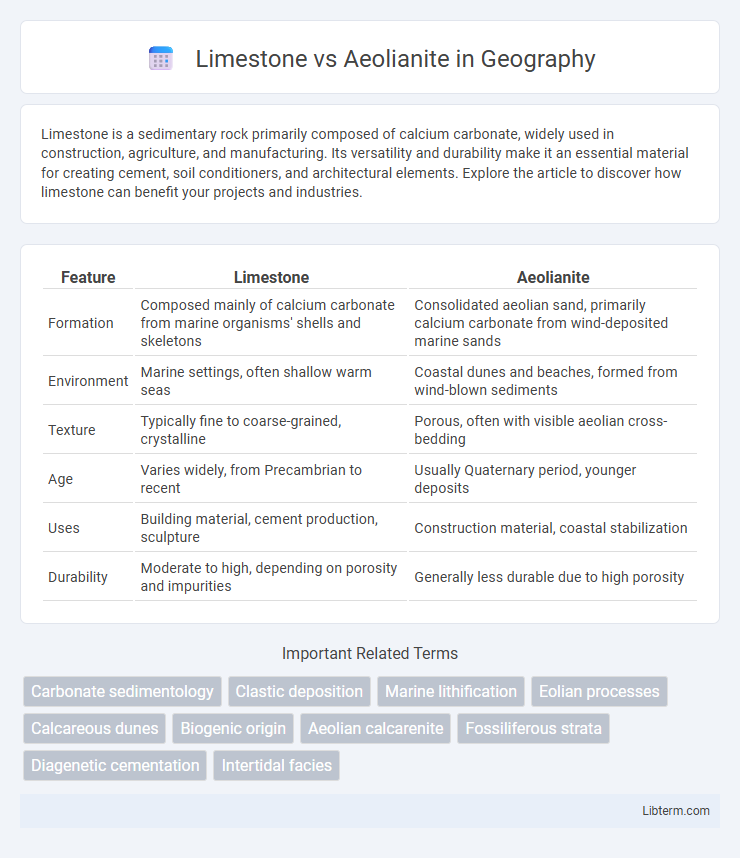Limestone is a sedimentary rock primarily composed of calcium carbonate, widely used in construction, agriculture, and manufacturing. Its versatility and durability make it an essential material for creating cement, soil conditioners, and architectural elements. Explore the article to discover how limestone can benefit your projects and industries.
Table of Comparison
| Feature | Limestone | Aeolianite |
|---|---|---|
| Formation | Composed mainly of calcium carbonate from marine organisms' shells and skeletons | Consolidated aeolian sand, primarily calcium carbonate from wind-deposited marine sands |
| Environment | Marine settings, often shallow warm seas | Coastal dunes and beaches, formed from wind-blown sediments |
| Texture | Typically fine to coarse-grained, crystalline | Porous, often with visible aeolian cross-bedding |
| Age | Varies widely, from Precambrian to recent | Usually Quaternary period, younger deposits |
| Uses | Building material, cement production, sculpture | Construction material, coastal stabilization |
| Durability | Moderate to high, depending on porosity and impurities | Generally less durable due to high porosity |
Introduction to Limestone and Aeolianite
Limestone is a sedimentary rock primarily composed of calcium carbonate, formed through the accumulation of marine organisms' skeletal fragments such as corals and shellfish. Aeolianite is a type of lithified dune limestone, created when wind-transported sand grains composed mainly of calcium carbonate become compacted and cemented over time. Both rocks are significant in coastal geology, but Limestone typically originates in marine environments, whereas Aeolianite forms in aeolian (wind-driven) settings.
Geological Formation Processes
Limestone forms primarily through the accumulation of calcium carbonate from marine organisms such as corals and shellfish, typically in warm, shallow marine environments where biological activity and sedimentation rates are high. Aeolianite, on the other hand, is a sedimentary rock formed by the cementation of wind-blown sand dunes, often composed of carbonate grains, in coastal or arid regions where wind erosion and deposition dominate. The key geological difference lies in limestone's marine biochemical origin versus aeolianite's terrestrial, wind-driven sedimentary process.
Key Physical Characteristics
Limestone is a sedimentary rock primarily composed of calcium carbonate, often exhibiting a fine to coarse grain texture with visible fossils and a consistent light color ranging from white to gray. Aeolianite, formed from cemented wind-blown sands, typically displays a more porous, sandy texture with cross-bedding structures and a pale beige to buff coloration. Both rocks differ in density and hardness, with limestone being denser and less permeable compared to the more friable and porous aeolianite.
Chemical Composition Comparison
Limestone primarily consists of calcium carbonate (CaCO3) formed from accumulated marine organisms, whereas Aeolianite contains a mixture of calcium carbonate and silicate minerals due to wind-deposited sand consolidation. The chemical composition of Aeolianite shows higher silica content compared to the almost pure calcium carbonate composition of limestone. Variations in mineralogical content affect the durability and porosity of both rock types, influencing their geological and industrial applications.
Common Locations and Occurrences
Limestone commonly occurs in marine environments such as shallow seas and coral reefs, prominently found in regions like the Mediterranean Basin, the Caribbean, and parts of the Middle East. Aeolianite forms through the cementation of wind-blown sand dune deposits, frequently occurring along coastal areas of Australia, South Africa, and the Mediterranean coastlines. Both rock types serve as important geological indicators of past environmental conditions, with limestone signaling marine sedimentation and aeolianite reflecting ancient dune ecosystems.
Uses and Applications
Limestone is widely used in construction for producing cement, concrete, and as a building stone due to its durability and abundance. Aeolianite, a type of cemented sand dune rock, is often utilized in coastal landscaping, erosion control, and as decorative stone in architectural facades. Both materials have distinct physical properties that determine their suitability for specific engineering, agricultural, and environmental applications.
Weathering and Erosion Resistance
Limestone exhibits moderate weathering resistance due to its calcite composition, making it susceptible to chemical erosion from acidic rain and groundwater, whereas Aeolianite, a cemented dune limestone with higher silica content, offers enhanced durability against both wind and water erosion. The porosity and cementation degree in Aeolianite contribute to its superior erosion resistance compared to traditional limestone, which often suffers surface pitting and structural weakening over time. In coastal and arid environments, Aeolianite's robust weathering resistance supports longer-lasting cliff formations and sedimentary structures relative to the more vulnerable limestone.
Environmental and Economic Impact
Limestone extraction often leads to significant environmental degradation, including habitat destruction, dust pollution, and high water usage, impacting local ecosystems. Aeolianite, formed from wind-transported carbonate sands, generally requires less intensive quarrying, reducing environmental disturbance but is regionally limited in availability. Economically, limestone is widely used in construction and industrial processes, driving substantial revenue, whereas aeolianite's niche applications in coastal erosion control and landscaping offer localized economic benefits with lower environmental costs.
Identification and Distinguishing Features
Limestone is a sedimentary rock primarily composed of calcite, characterized by its fine-grained texture and frequent fossil inclusions, whereas aeolianite is a type of cemented sand dune formed by wind-deposited carbonate sands. Limestone typically exhibits a more homogeneous structure with visible fossil fragments and reacts vigorously to dilute hydrochloric acid, while aeolianite shows cross-bedding indicative of wind action and often has a more porous, grainy appearance. Identification involves examining texture, fossil content, and sedimentary structures, with aeolianite's formation linked to coastal dune environments differentiating it from marine-deposited limestone.
Summary: Choosing Between Limestone and Aeolianite
Limestone offers durability and versatility, commonly used in construction and landscaping due to its dense composition and resistance to weathering. Aeolianite, cemented by wind-blown sand particles, provides a unique porous texture ideal for coastal architecture and erosion-prone environments. Selecting between limestone and aeolianite depends on the specific application requirements, environmental exposure, and aesthetic preferences, with limestone suited for strength and aeolianite favored for its distinctive appearance and natural insulation properties.
Limestone Infographic

 libterm.com
libterm.com